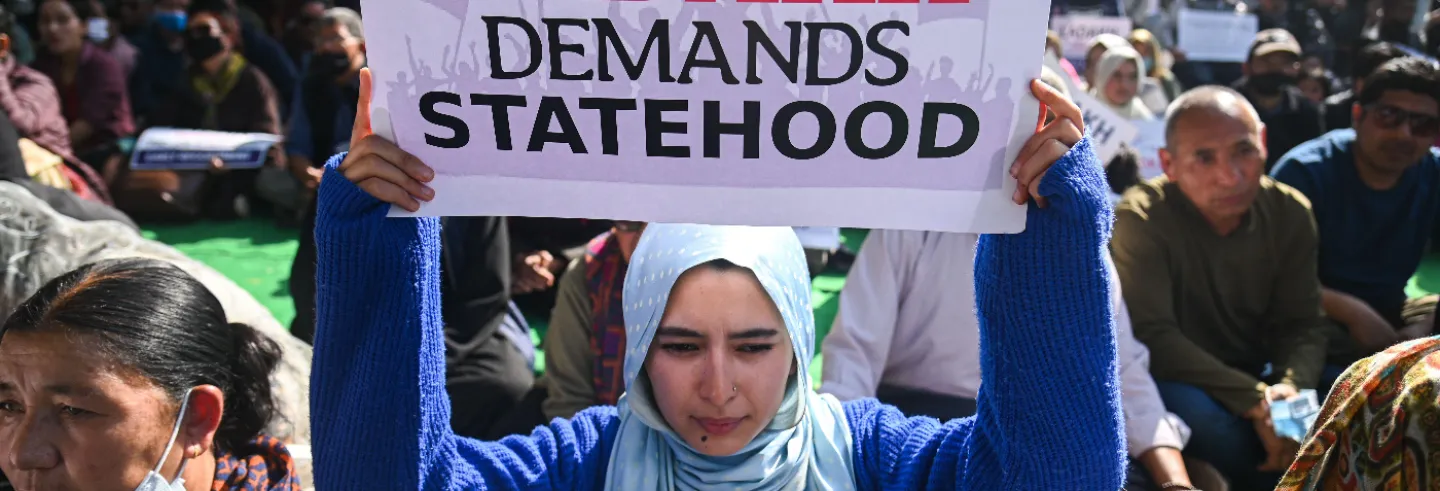On 11 December 2023, the Supreme Court of India gave its stamp of approval to the union government’s decision to abrogate Article 370 to “fully integrate” Jammu and Kashmir into India. Based on a promise made by the solicitor general, the court refrained from deciding whether the conversion of the erstwhile state into union territories was constitutionally valid and ordered that elections to the assembly of the union territory of Jammu and Kashmir be held within a specific time period.
While the judgment has been critiqued on various grounds, this article will try to unravel the implications of the court’s decision on the principle of federalism in the Indian context. The focus here is not on the manner in which Article 370 was abrogated, and the logic behind the court’s decision to uphold it. The focus, rather, is on the dissolution of the state of Jammu and Kashmir into union territories and the implications of the court refusing to hold this decision unconstitutional.
Federalism
Federalism refers to a system of government where power is shared between the central government of a State and its various constituent units so that the union government and the state governments can exercise their sovereign powers independently of each other in certain areas. The primary feature of federalism is that powers are divided between the union and the states, and the states have autonomy in governing their territories.
A classic example of a federal state is the United States of America. Each state has its own constitution, its own sets of laws and regulations, and its own supreme court. The principle of federalism is so deeply ingrained in the US that Donald Trump’s efforts during his presidency to aggressively use his executive powers through executive orders and regulatory changes were frequently undercut by state governors and legislatures.
Every constituent unit of the USA has equal representation and power in matters concerning the nation as a whole. In contrast, India has always been described as a “quasi-federal” state rather than purely federal or purely unitary one.
Trump’s deployment of federal forces to deal with Black Lives Matter protests in various states was also met with significant opposition from local leaders, especially in the city of Portland. This resulted in a law suit being filed by the Oregon State Department of Justice against federal agencies. Eventually, the Trump administration had to agree to draw down federal agencies in Oregon and allow local agencies and police officers to fulfil their roles.
Further, each state, irrespective of its size and population sends two senators to the US Senate. Thus, every constituent unit of the USA has equal representation and power in matters concerning the nation as a whole. In contrast, India has always been described as a “quasi-federal” state rather than purely federal or purely unitary one.
India’s federalism is unique. It is described as a “Union of States” in Article 1 of the Constitution. There is a constitutional mechanism for the separation of powers between the union and the various state governments in the form of three lists – the union list, the concurrent list, and the state list. In matters enumerated under the state list, the state governments have primacy. They can decide policies and frame laws independent of the wishes and desires of the union. The supremacy of the Constitution is recognised and the separation of powers in considered sacred. However, India’s federalism undeniably has a tilt towards the union.
This tilt towards the union is evident from that legislative power over matters not mentioned in the three lists automatically vests with the union under entry 97 of the union list. This means that the power to regulate any new and emerging field automatically vests with the union. The effects of this can already be seen – the state governments cannot formulate their own policies on information technology (IT) and the use of artificial intelligence (AI) independently as these are matters to be regulated by the union.
Further, the union can traverse into the state list if a national emergency is proclaimed. The President has the power to dissolve a state legislature and impose an emergency and take over the administration of the state in situations where it is not acting in accordance with the Constitution.
Elevating the concept of federalism to the status of being a part of the “basic structure” of the Constitution necessarily implies that India has and maintains federal features and that the federal features must be protected at all costs.
Irrespective of this asymmetry, the importance of federalism in the Indian context and maintaining the balance of powers between the union government and the state governments cannot be understated. Despite initially holding that India was not federal in the 1960s, the Supreme Court in Kesavananda Bharathi vs State of Kerala held in no uncertain terms that federalism was a part of the “basic structure” of the Constitution. The court has re-emphasised this numerous times. In S.R. Bommai, the Supreme Court severely limited the power of the union to unilaterally dismiss elected state governments.
Elevating the concept of federalism to the status of being a part of the basic structure of the Constitution necessarily implies that (a) India undoubtedly has and maintains federal features and that (b) the federal features of the nation must be respected and protected at all costs. This obviously means that the union cannot act unilaterally to assume more powers than allowed by the Constitution and tilt the balance of powers in its favour.
States, Union Territories, and Autonomy
It is clear that the status of “statehood” is very important for a territory and its population to participate in the federal structure of the nation. New Delhi in India and Puerto Rico in the US have been aspiring to achieve statehood for a long time.
The aspirational value of statehood need not be explained. Territories and their populations want to participate in national governance, as well as exercise greater autonomy in local governance. B.R. Ambedkar stated to the Constituent Assembly, “The states under our Constitution are in no way dependent upon the centre for their legislative or executive authority. The centre and the states are coequal in this matter.”
In State (NCT of Delhi) vs Union of India, the Supreme Court emphasised the importance of statehood in the Indian context by stating, “The interest of the states inherent in a federal form of government gains more importance in a democratic form of government as it is absolutely necessary in a democracy that the will of the people is given effect to. To subject the people of a particular state/region to the governance of the union, that too, with respect to matters which can be best legislated at the state level goes against the very basic tenet of a democracy.”
Union territories do not have the same level of autonomy as states, which exercise considerable constitutional autonomy in their functioning. States have their own legislative assemblies, a great degree of autonomy, and are fully accountable to the people while union territories are administered by the centre and only accountable to the centre. Even in union territories that have their own legislative assemblies (like Puducherry and Delhi), the level of autonomy exercised by them, while being higher than the autonomy exercised by other union territories, is significantly lower than the autonomy exercised by states. But why were union territories created in the first place?
Clearly, the constitutional scheme and vision does not envisage depriving the states and union territories of their autonomy except temporarily, that too in extraordinary emergencies.
The basis for their creation was a report of the States Reorganisation Committee, which recommended the creation of “centrally administered units” if, for “strategic, security or other compelling reasons” it was not possible to integrate these territories into states and provide them with greater autonomy. However, it must be noted that the report foresaw a constant development of autonomy and envisaged that the territories would be put on a path to attaining autonomy either by being merged with another state or otherwise. (Ironically, this is acknowledged by the Supreme Court in the Article 370 judgment.) Of course, many union territories have “attained statehood” (Himachal Pradesh in 1970, Manipur and Tripura in 1971 and Mizoram and Arunachal Pradesh in 1981).
Clearly, the constitutional scheme and vision does not envisage depriving the states and territories of their autonomy except temporarily, that too in extraordinary emergencies.
Dissolution of the state
Ancillary to the abrogation of Article 370 was the dissolution of the state of Jammu and Kashmir into three union territories (which all continue to have no local government). Article 3 of the Indian Constitution provides the union government with the power to change the boundaries of states, to carve out a new union territory/state from an existing state, or to merge two or more states/union territories to form a new state. Of course, in line with the principle of federalism, such changes can only be made after ascertaining the views of the state legislature. Crucially missing from Article 3 is the power to convert the entirety of a state into one or more union territories.
The power to unilaterally dissolve a state is the most glaring, egregious, and blatant violation of the principle of federalism. It should have been easy for the court to make this clear and order a restoration of statehood.
Article 3 could give the power to the union to end the existence of a state. The erstwhile State of Bombay no longer exists and was separated into the states of Maharashtra and Gujarat. The crucial difference is that in the case of the State of Bombay, the character of statehood was left untouched. The territories in question still enjoyed full statehood and the benefits that flow from the status. However, in the case of Jammu and Kashmir, no part of the erstwhile state retains the character of statehood. In effect, an entire federal unit of India has been dissolved and stripped of statehood at a time the territory had no local government or representative to even object or protest about it.
The power to unilaterally dissolve a state is the most glaring, egregious, and blatant violation of the principle of federalism. It should have been easy for the court to make this clear and order a restoration of statehood as soon as possible, considering arguments on the issue had been heard by it. But, once again, the court totally abdicated its responsibility and opted not to decide.
The judgment relies on an assurance made by the solicitor general that statehood shall be restored and leaves the issue to be decided at a future date when an appropriate case comes up. Is this how a constitutional court functions?
May I ask what the Supreme Court is waiting for? Should we wait for the union to unilaterally dissolve a state like West Bengal, Tamil Nadu, or Kerala without consulting the legislatures of those states (or by doing away with their legislatures by using its power to impose emergencies)? Then wait for the issue to be brought before the Supreme Court, where it languishes for a couple of years before it is heard? And again wait for a period after the judgment is reserved?
The playbook is simple now.
a) Impose a state emergency and dissolve the legislature.
b) Do whatever you want with the state, including stripping it of its statehood.
It would not have taken much for the court to make its stance clear, to uphold the principle of federalism, and to protect the rights of states against a union that seems hell bent on destroying the federal structure of the union. What is even more shocking is that this decision not to decide on the issue comes after pages and pages of eloquent statements discussing federalism, democracy, the importance of statehood and autonomy, and the history of union territories.
Unfortunately, this seems to be the Supreme Court we have today – a court that makes all the right noises while discussing an issue but fails to take decisive action when the time to follow through arrives. It looks like this is all we can expect.
Vikas Muralidharan, a legal academician and researcher, is a lecturer at the School of Law, Sai University, Chennai.









